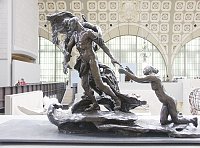
|
This work is usually seen as an allegory of Man leaving Youth and being carried off by Death. The official guide to sculpture in the Musée d'Orsay, describes this work: ". . .in Maturity the man dragged along on the wave of life by the old woman is bending down. The young imploring figure, her hands now empty, has lost. Paul Claudel described her thus: 'This composition, whose unity springs from a rupture...this naked young woman, is my sister! My sister Camille. Imploring, humiliated on her knees, this haughty, proud woman...and do you know what is being torn from her, at that moment, before your very eyes--her soul!'" (80) Thus this work can be read as autobiographical, sometimes more specifically as representing a triangle in which the man is Rodin, the imploring young woman, Camille, and the old woman, Rose Beuret, or more generally as a symbolic representation of the painful break between Claudel and Rodin. |


 Click here to return to index of art historical sites.
Click here to return to index of art historical sites.
 Click here to return to index of artists and architects.
Click here to return to index of artists and architects.
 Click here to return to chronological index.
Click here to return to chronological index.
 Click here to see the home page of Bluffton University.
Click here to see the home page of Bluffton University.

